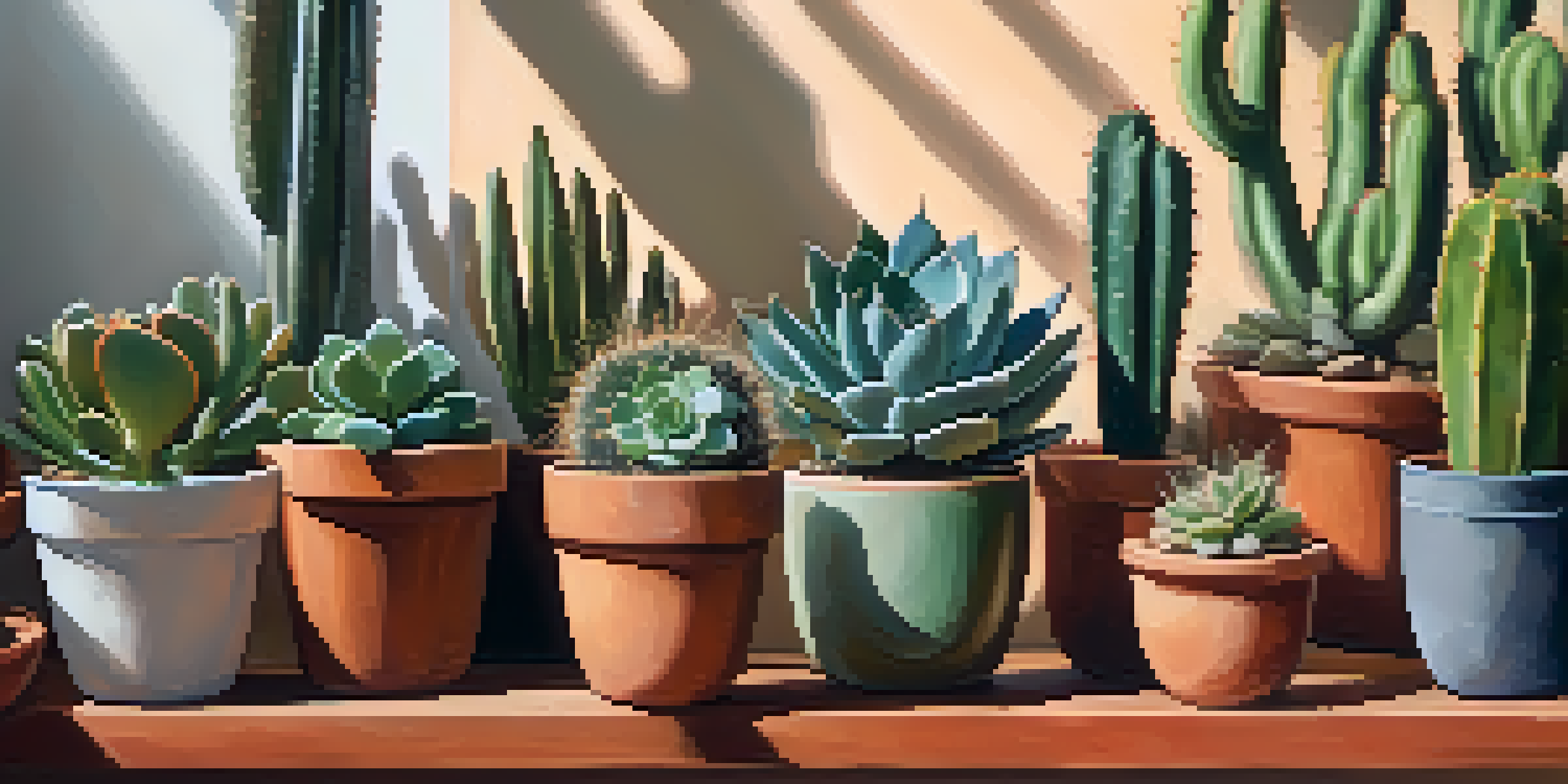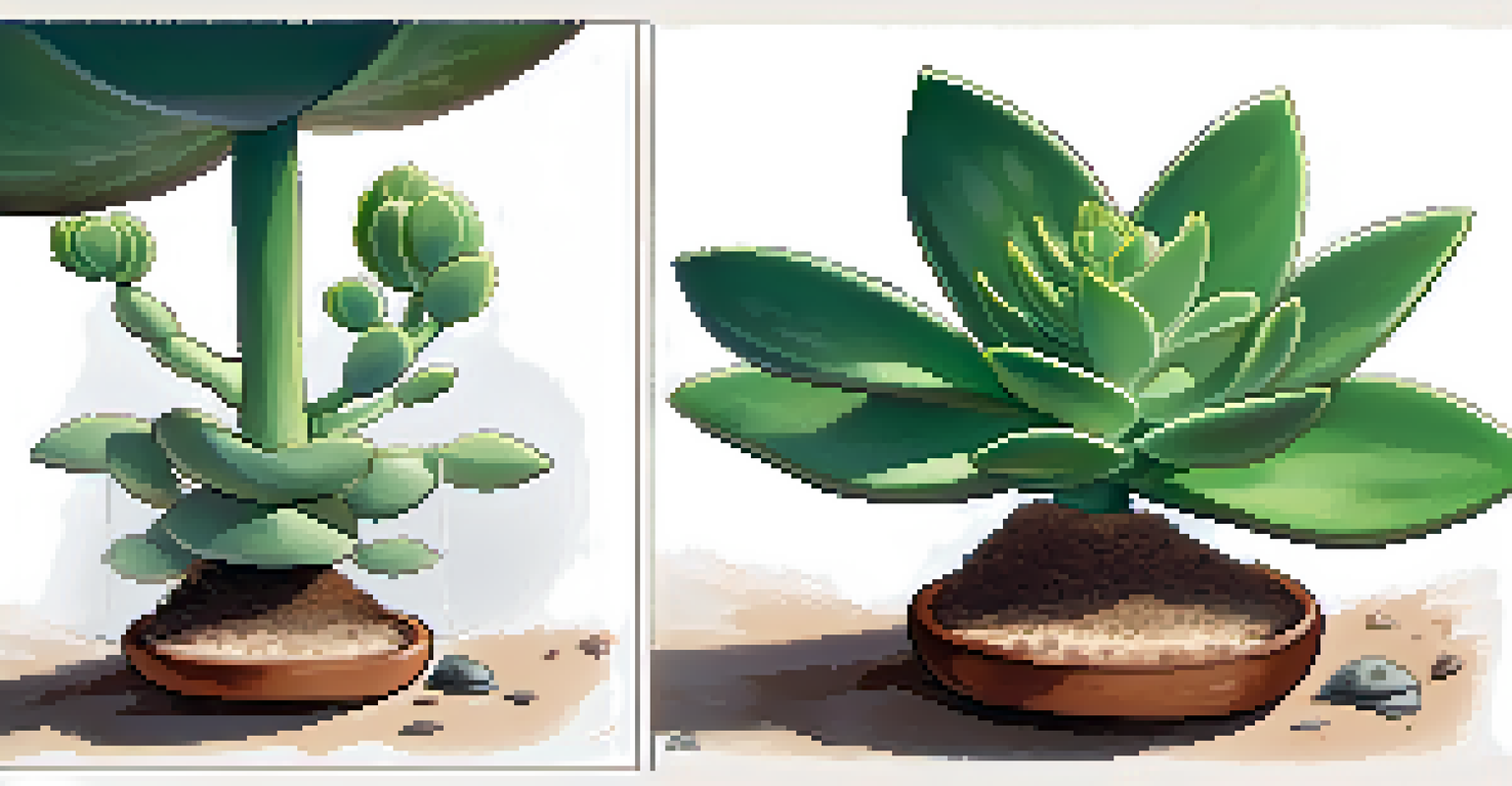Propagating Cacti and Succulents: Methods and Best Tips

Understanding Cacti and Succulent Propagation Basics
Propagation is the process of creating new plants from existing ones, and it's especially rewarding with cacti and succulents. These plants are known for their resilience and unique beauty, making them popular choices for indoor and outdoor gardens. By understanding the basics of propagation, you can easily expand your collection or share with friends.
The love of gardening is a seed once sown that never dies.
Both cacti and succulents can be propagated through various methods, such as stem cuttings, leaf cuttings, and offsets. Each method has its own nuances, but all require some patience and care. The good news is that with a little practice, you'll find it’s easier than it seems to grow new plants from your favorites.
Whether you're looking to save a struggling plant or simply want more greenery in your space, getting comfortable with propagation is key. This article will guide you through the best methods and tips to ensure successful propagation of your cacti and succulents.
Choosing the Right Time for Propagation
Timing is everything when it comes to propagating cacti and succulents. The best time to start the process is during the growing season, typically in spring or early summer. This is when these plants are most active and can recover more quickly from cutting or stress.

If you attempt to propagate during the dormant season, you might find your plants take longer to root or may not take root at all. So, keep an eye on the calendar and ensure your plants are ready to thrive before diving into propagation. This will set you up for success right from the start.
Propagation Basics for Beginners
Understanding the various methods of propagating cacti and succulents can help you expand your plant collection successfully.
Additionally, understanding your specific plant's needs can aid in timing. Some varieties may have unique growth patterns, so do a little research beforehand to align your efforts with their natural cycles.
Gathering the Right Tools for Successful Propagation
Before starting your propagation journey, it’s essential to gather the right tools and materials. You’ll need sharp, clean scissors or a knife to make clean cuts, as well as pots, soil, and possibly rooting hormone. Using the right equipment can help prevent damage to your plants and promote healthy growth.
To plant a garden is to believe in tomorrow.
Choosing a well-draining soil mix is crucial for both cacti and succulents, as they thrive in dry conditions. Look for a blend specifically designed for these types of plants, which often includes sand, perlite, or pumice. Having the right soil will help ensure your cuttings don’t rot and have the best chance of rooting successfully.
Additionally, consider using small pots to start your cuttings, as they allow for better moisture control and root development. Having these tools at hand will make the propagation process much smoother and more enjoyable.
Effective Methods: Stem Cuttings for Cacti and Succulents
One of the most popular propagation methods is through stem cuttings, which works well for both cacti and succulents. To start, take a healthy stem, ideally with several segments, and cut it at an angle to maximize surface area. This method allows the plant to heal and reduces the risk of rot.
After cutting, let the stem sit in a dry place for a few days to form a callus over the cut end. This is an important step because it helps prevent rot when you eventually plant it in soil. Once the cut end is calloused, you can place it in your chosen potting mix.
Timing is Key for Success
Propagating during the growing season, typically in spring or early summer, enhances the chances of successful rooting.
Water sparingly in the beginning and keep an eye on the cutting for signs of new growth. With a bit of patience, you’ll notice roots starting to form, and soon enough, you’ll have a new cactus or succulent to enjoy!
Utilizing Leaf Cuttings for Succulent Propagation
Leaf cuttings are a fantastic way to propagate succulents, particularly varieties like Echeveria or Jade plants. This method involves removing a healthy leaf from the plant, ensuring you get a clean cut at the base. It’s an easy and rewarding approach that can yield several new plants from just one leaf.
Once you’ve removed the leaf, let it dry for a few days to form a callus, just like with stem cuttings. This step is crucial in preventing rot when you place it in soil. After it’s calloused, lay the leaf flat on well-draining soil and lightly mist it to keep the moisture level up without overdoing it.
With time, you should see tiny roots and new growth emerging from the base of the leaf, indicating that your propagation efforts are paying off. This method not only produces new plants but can also be a fun project to share with family and friends.
Propagating Offsets: A Natural Method for Cacti
Offsets, or pups, are small plants that grow around the base of mature cacti and can be an excellent way to propagate. This method is particularly effective for cacti like the Mother-in-Law's Tongue or certain varieties of Agave. When the offset reaches a size that’s about one-third the size of the parent plant, it's time to separate it.
To do this, gently twist or cut the offset away from the parent, taking care not to damage the roots. Once removed, let the offset dry for a few days to form a callus before planting it in its own pot with well-draining soil. This will ensure that it doesn’t rot when you place it in its new home.
Essential Tools for Propagation
Gathering the right tools and materials, such as sharp scissors and well-draining soil, is crucial for effective plant propagation.
Offsets are a fantastic way to multiply your cacti collection with minimal effort. Plus, they often establish roots quickly, making them a rewarding option for both novice and experienced gardeners alike.
Care Tips for Newly Propagated Plants
After propagating your cacti and succulents, proper care is essential for their survival and growth. Begin by placing your new plants in a bright but indirect light location. Direct sunlight can be too intense for young cuttings, so giving them a bit of shade will help them acclimate.
Watering should be minimal at first—just enough to keep the soil slightly moist without drowning the plants. It’s better to underwater than overwater during this delicate stage. As the roots develop and you see new growth, you can gradually increase the water frequency and exposure to sunlight.

Lastly, keep an eye out for pests or diseases, as new plants can be vulnerable. Regularly check for any signs of distress and take action if needed. With a little TLC, your newly propagated cacti and succulents will thrive and grow into beautiful additions to your home.